Ford
Expedition Rear Brake Pads Replacement Guide
How to change the rear disc brake pads on
a fourth generation 2018, 2019 and 2020 Ford Expedition SUV.
By Paul B. Michaels Author & Photographer Auto Mechanic Since 1989 |
||
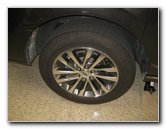 2018 Expedition - Rear |
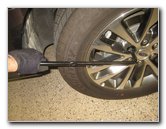 Slightly Loosen Lug Nuts |
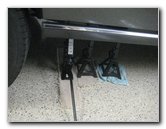 Raise Rear of SUV |
| This automotive
maintenance tutorial was specifically written to assist owners of the 4th
generation (2018, 2019, 2020 and probably also the 2021, 2022 and 2023 model
years) Ford Expedition SUV in changing the rear disc brake pads and
lubricating the caliper slider pins. (Also including written directions for
replacing the rotors as well.) Owners of other Ford or Lincoln vehicles such as the Explorer, F-150, Escape, EcoSport, Transit, F-350, F-250, Edge, Flex, Ranger, Fiesta, Focus, Fusion, Mustang, Bronco, Super Duty, Navigator, Continental, MKZ, MKX, MKC, MKT, Aviator, Corsair and Nautilus may also find these DIY instructions to be helpful. A few compatible sets of new rear brake pads with their part numbers include the following: Power Stop 17-1790, Centric 301.17900, Bendix CFC1790 and R1 Concepts # 2310-1790-00. The tools and other items needed to complete this procedure include a lug nut wrench, a floor jack, two jack stands, a 10mm socket and a 1/4" or 3/8" ratchet or a 10mm wrench, an 18mm wrench, a Lisle 28600 disc brake piston tool and a tube of brake caliper grease. The first few steps are to drive the SUV on to a level surface, shift the transmission into "Park" and turn off the ignition. Make sure that the emergency / parking brake is NOT engaged. If the parking brake is on, you will not be able to pull the rear caliper off the old pads and out of the bracket.
1. Turn the ignition switch to the "ON"
position but do not start the engine. If you can not place your electronic parking brake into "maintenance mode" do not continue with this procedure and consult your dealership. Place wheel chocks on both sides of the front tires to prevent the vehicle from moving. The floor jack and lug nut wrench are located in the cargo area under the floor board in the right (passenger) side storage compartment. Slightly loosen the six lug nuts on the rear wheel by turning them about 1/4 to 1/2 turn in the counterclockwise direction with the tire iron. Carefully raise the rear of the SUV with the floor jack and securely support it with at least two jack stands. Please do not solely rely on the floor jack to support the vehicle. |
||
|
|
||
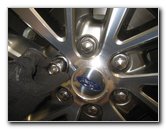 Spin Off Six Lug Nuts |
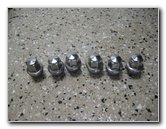 Lug Nuts Removed |
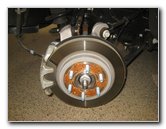 Caliper, Bracket & Rotor |
| I prefer to only
work on one side of the vehicle at a time to keep three tires on the ground
for extra safety. Spin off the six lug nuts and set them aside in a safe place. Carefully remove the rear wheel to reveal the caliper, bracket, rotor and suspension. Some home mechanics choose to place the wheel and tire under the frame rail as an extra backup support device just in case the floor jack and both jack stands fail. |
||
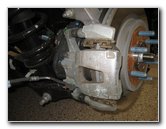 Rear Brake Caliper |
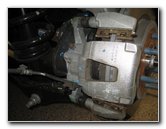 Two Caliper Bolts |
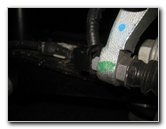 Wire Loom Plastic Mount |
| The rear brake
caliper is held in place to the bracket by two bolts on the rear side of the
caliper. The bolt heads face in towards the cargo area. There is a wire loom attached to the threads on the top of the lower caliper bolt. |
||
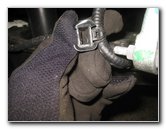 Pull Wire Loom Off Bolt |
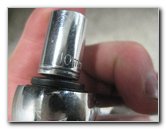 10mm Socket & Ratchet |
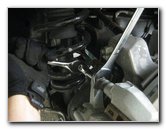 Hold Slider Pin - Wrench |
| Pull the plastic
retaining clip off the lower bolt and move the wire loom out of the way. Attach the 10mm socket to a 1/4" or 3/8" drive ratchet. Loosen the top caliper bolt by turning it in the clockwise direction (when viewed from the outside of the vehicle) with the 10mm socket and a ratchet. If the caliper slider pin turns as you are attempting to loosen the caliper bolt, hold it in place with an 18mm wrench. |
||
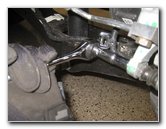 Loosen Lower Caliper Bolt |
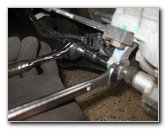 Hold Pin With Wrench |
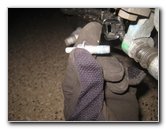 Lower Bolt Removed |
| Then loosen the lower caliper bolt by also turning it in the clockwise direction (as seen from the outside of the SUV) with the 10mm socket. | ||
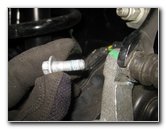 Spin Out Top Bolt |
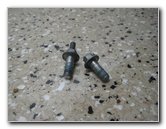 Two Bolts Removed |
 Lift Caliper Off Pads |
| Spin out the two
caliper bolts and set them aside in a safe place. Carefully lift the rear caliper out of the bracket and off the old pads. Try to avoid bending, kinking, twisting or stressing the rubber brake fluid hose. |
||
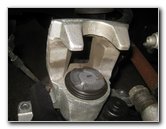 Screw-In Type Piston |
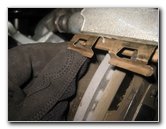 Pull Out Old Pads |
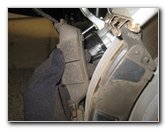 Remove Old Inner Pad |
| Rest the caliper on
the rotor or suspend it from the suspension spring with a bungee cord or
some twine. Pull the old inner and outer brake pads out of the bracket. |
||
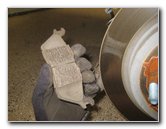 Remove Old Outer Pad |
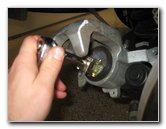 Turn Back / Retract Piston |
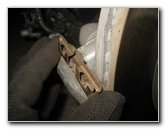 Pad Abutment Clips |
| If one of your old
pads is equipped with a wear indicator bar or "squeal" bar, make a mental
note of where it is located.
The Ford service manual specifies that the rear brake caliper does not need to be turned back, so you may find that just carefully pushing in may work to retract the piston. The service manual states "When replacing rear brake pads in maintenance mode, the brake caliper piston must be compressed into the caliper housing. The brake caliper piston does not have to be rotated while compressing the piston." So you may be able to use an "F" clamp and the back of an old pad to evenly push the piston back into the caliper. If you have trouble retracting the piston, stop and consult your dealership or a Ford certified mechanic. At the time of performing this rear brake job, I thought that in order for the caliper to fit over the thicker new brake pads, the "screw-in" type caliper piston would need to be retracted by turning it back into the caliper. It sounds like the Ford service manual contradicts this procedure. I test fit the various sides of the Lisle 28600 disc brake piston tool to find the side that has the best fit on the caliper piston. I attached the tool to a short extension bar and a 3/8" drive ratchet. I slowly turned the "screw-in" type piston in the clockwise direction to retract it back into the caliper. If you encounter some resistance, move to the right rear area of the engine bay and twist off the round black plastic cap on the brake fluid reservoir. You may also need to push in a bit as you turn back the caliper piston. Removing the cap on the reservoir bottle will allow the brake fluid to more easily travel back through the lines. Continue turning or compressing back the piston until it is just about flush with the rubber dust boot that surrounds it. So I may have gotten lucky since turning and pushing the caliper piston seemed to work. But keep in mind that the service manual says that it does not have to be rotated. As soon as you are done retracting the piston, replace the reservoir cap. Brake fluid is hygroscopic, so it readily absorbs moisture from the air. If the brake fluid absorbs too much water from the air, it may lead to reduced braking performance. If your new set of rear pads includes a bag of replacement brake hardware, pull the old pad abutment or "anti-rattle" clips out of the top and bottom of the bracket. Clean off the rotor, lug studs, caliper and bracket with some CRC brake cleaner spray. Avoid breathing in the cleaning spray or the brake dust since they may be carcinogenic (cancer causing). Apply a thin layer of brake caliper grease to the top and bottom of the pad abutment clips where they will come in contact with the bracket or the new pads. Push the new pad abutment clips into the top and bottom of the bracket. Make sure the clips are fully seated in the bracket. If you've been experiencing shuddering, vibrating or shaking in the rear end while braking, the OEM rear rotors might be warped and should be replaced. A few compatible replacement rear rotors with their part numbers are as follows: Raybestos 682263FZN, Power Stop AR85195EVC and DuraGo BR901652. To replace the rear rotors, remove the two bracket bolts and take off the bracket. Slide the old rotor off the lug studs and wheel hub. Slide the new rotor into place and re-attach the bracket with the two bolts. The torque specification for the rear bracket bolts on the new Expedition should be similar to the Ford Flex which is 76 lb-ft. Please use your best judgment and make sure the bracket bolts are snug. If you often drive off-road, consider using some Loctite Blue (medium - removable with hand tools) or Loctite Red (heavy duty - requires heat for removal) threadlocker adhesive fluid on the bracket bolts to help prevent them from vibrating loose. |
||
|
|
||
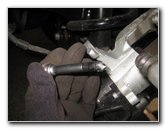 Caliper Slider Pins |
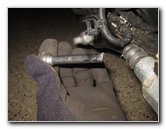 Lubricate Slider Pins |
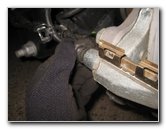 Replace Slider Pins |
| In order for the
caliper to operate smoothly, the two caliper slider pins or "guide bolts"
need to be well lubricated. Do not mix up the top and bottom caliper slider pins. On some Ford models, the two pins are slightly different and should be not be swapped. Remove one caliper slider pin at a time from its rubber dust boot attached to the bracket. Apply a thin layer of brake parts lubricant grease to the smooth parts of the pin before pushing it back into the accordion style rubber dust boot. Turn the pins a few times to help spread the grease. |
||
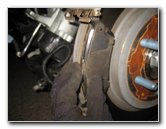 Install New Brake Pads |
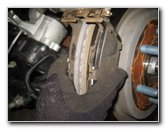 Push Pads Against Rotor |
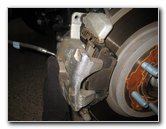 Lower Caliper Over Pads |
| Install the new
outer and inner brake pads into the bracket. Push the two pads together until they are flush against the rotor. Carefully lower the caliper over the new pads and into the bracket. If the caliper won't fit over the thicker new brake pads, you may need to turn back the piston a bit more. |
||
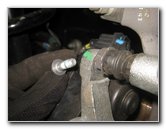 Spin In Top Caliper Bolt |
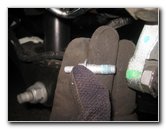 Replace Lower Bolt |
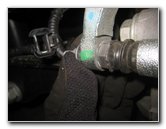 Spin In By Hand |
| Line up the bolt
holes in the caliper with the corresponding holes in the slider pins within
the bracket. The caliper bolt with the extra threads attached to the bolt head should be situated at the bottom of the caliper. Spin in the two caliper bolts a few turns by hand in the counterclockwise direction (when viewed from the outside of the SUV) to help prevent them from becoming cross threaded. |
||
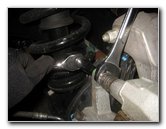 Tighten Top Caliper Bolt |
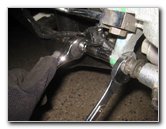 Tighten Bottom Bolt |
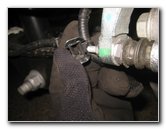 Push On Wire Mount |
| Tighten the two
caliper bolts with the 10mm socket and a ratchet or a 10mm wrench to just
past hand tight. The torque specification for the rear caliper bolts in the service manual for the previous generation Expedition is 22 lb-ft which sounds about right for these small 10mm bolts on the new Expedition. If you often drive off-road consider applying a small amount of Loctite Blue (medium - removable with hand tools) to the two caliper bolts to help prevent them from vibrating loose. Double check that the two caliper bolts are tight before moving on to the next steps. Push the mounting bracket for the wire loom on to the exposed threads on the lower bolt head. |
||
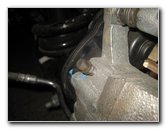 Rubber Valve Cap |
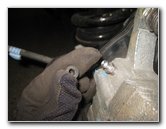 Brake Fluid Bleeder Valve |
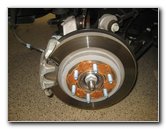 New Brake Pads Installed |
|
If your brake pedal has been feeling soft or spongy, the brake fluid might
contain some air bubbles or moisture. It would be best to bleed the brake
fluid at this time and replace it with fresh DOT 4 fluid. I highly recommend using the Allstar Performance Bleeder Bottle since it makes bleeding the brake lines an easy one person job. Check out my Acura MDX Brake Line Bleeding Guide for more information on this topic and how to use the bleeder bottle. The brake fluid bleeder valve is located on the back side of the caliper just below the top caliper bolt. |
||
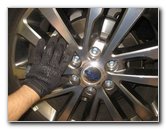 Replace Rear Wheel |
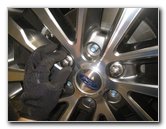 Spin On Six Lug Nuts |
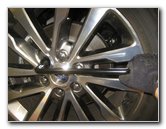 Slightly Tighten Lug Nuts |
| Carefully push the
rear wheel back into place over the lug studs. Spin on the six lug nuts a few turns by hand in the clockwise direction to help prevent them from becoming cross threaded. Slightly tighten the six lug nuts in a criss-cross or "star" pattern with the lug nut wrench. |
||
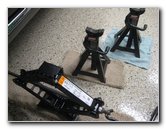 Lower Car From Stands |
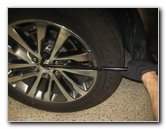 Torque Lug Nuts |
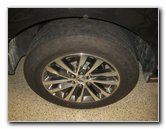 Brake Job Complete! |
| Carefully lower the
SUV from the jack stands by using the floor jack. Continue tightening the lug nuts in the "star" or "criss-cross" pattern to about 1/8th to 1/4th of a turn past hand tight. It would be best to use a torque wrench to tighten the lug nuts to the 150 lb-ft (204 Nm) specification in the owner's manual. Attention - To exit the EPB
(electronic parking brake) "service" or "maintenance" mode, follow these
steps. Sit in the driver's seat and firmly push the brake pedal a few times to help restore the brake line pressure. I also recommend re-checking the lug nuts after your next trip and to look for drops of fresh brake fluid on your driveway, parking spot or garage floor which might indicate a leak from the bleeder valve or the reservoir. Check the brake fluid level in the reservoir. If necessary, pour in some new DOT 4 brake fluid until it reaches the "MAX" (maximum) line. Be sure to write down the brake pad change in your SUV's service records. Please
check out all of my
2018-2020 Ford Expedition DIY Repair & Maintenance Guides. |
||
| If you found this guide to be helpful,
please consider making a small donation by clicking on the PayPal.com
"Donate" button located to the right of this paragraph. Thank you!
(Note: I am not a registered charity. Donations are not tax deductible.) |

